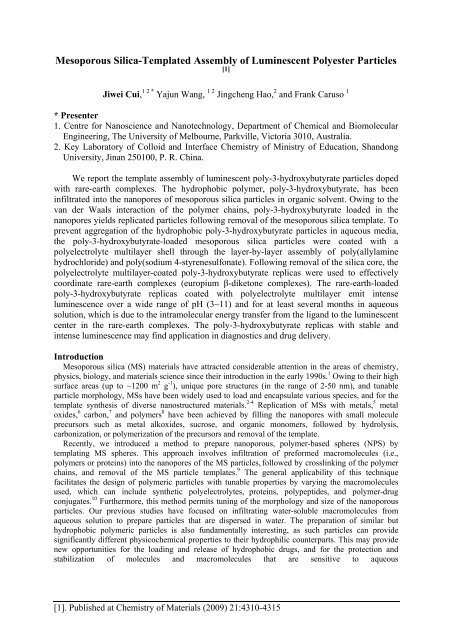Workshop proceeding - final.pdf - Faculty of Information and ...
Workshop proceeding - final.pdf - Faculty of Information and ...
Workshop proceeding - final.pdf - Faculty of Information and ...
Create successful ePaper yourself
Turn your PDF publications into a flip-book with our unique Google optimized e-Paper software.
Mesoporous Silica-Templated Assembly <strong>of</strong> Luminescent Polyester Particles<br />
[1]<br />
Jiwei Cui, 1 2 * Yajun Wang, 1 2 Jingcheng Hao, 2 <strong>and</strong> Frank Caruso 1<br />
* Presenter<br />
1. Centre for Nanoscience <strong>and</strong> Nanotechnology, Department <strong>of</strong> Chemical <strong>and</strong> Biomolecular<br />
Engineering, The University <strong>of</strong> Melbourne, Parkville, Victoria 3010, Australia.<br />
2. Key Laboratory <strong>of</strong> Colloid <strong>and</strong> Interface Chemistry <strong>of</strong> Ministry <strong>of</strong> Education, Sh<strong>and</strong>ong<br />
University, Jinan 250100, P. R. China.<br />
We report the template assembly <strong>of</strong> luminescent poly-3-hydroxybutyrate particles doped<br />
with rare-earth complexes. The hydrophobic polymer, poly-3-hydroxybutyrate, has been<br />
infiltrated into the nanopores <strong>of</strong> mesoporous silica particles in organic solvent. Owing to the<br />
van der Waals interaction <strong>of</strong> the polymer chains, poly-3-hydroxybutyrate loaded in the<br />
nanopores yields replicated particles following removal <strong>of</strong> the mesoporous silica template. To<br />
prevent aggregation <strong>of</strong> the hydrophobic poly-3-hydroxybutyrate particles in aqueous media,<br />
the poly-3-hydroxybutyrate-loaded mesoporous silica particles were coated with a<br />
polyelectrolyte multilayer shell through the layer-by-layer assembly <strong>of</strong> poly(allylamine<br />
hydrochloride) <strong>and</strong> poly(sodium 4-styrenesulfonate). Following removal <strong>of</strong> the silica core, the<br />
polyelectrolyte multilayer-coated poly-3-hydroxybutyrate replicas were used to effectively<br />
coordinate rare-earth complexes (europium β-diketone complexes). The rare-earth-loaded<br />
poly-3-hydroxybutyrate replicas coated with polyelectrolyte multilayer emit intense<br />
luminescence over a wide range <strong>of</strong> pH (3~11) <strong>and</strong> for at least several months in aqueous<br />
solution, which is due to the intramolecular energy transfer from the lig<strong>and</strong> to the luminescent<br />
center in the rare-earth complexes. The poly-3-hydroxybutyrate replicas with stable <strong>and</strong><br />
intense luminescence may find application in diagnostics <strong>and</strong> drug delivery.<br />
Introduction<br />
Mesoporous silica (MS) materials have attracted considerable attention in the areas <strong>of</strong> chemistry,<br />
physics, biology, <strong>and</strong> materials science since their introduction in the early 1990s. 1 Owing to their high<br />
surface areas (up to ~1200 m 2 g -1 ), unique pore structures (in the range <strong>of</strong> 2-50 nm), <strong>and</strong> tunable<br />
particle morphology, MSs have been widely used to load <strong>and</strong> encapsulate various species, <strong>and</strong> for the<br />
template synthesis <strong>of</strong> diverse nanostructured materials. 2-4 Replication <strong>of</strong> MSs with metals, 5 metal<br />
oxides, 6 carbon, 7 <strong>and</strong> polymers 8 have been achieved by filling the nanopores with small molecule<br />
precursors such as metal alkoxides, sucrose, <strong>and</strong> organic monomers, followed by hydrolysis,<br />
carbonization, or polymerization <strong>of</strong> the precursors <strong>and</strong> removal <strong>of</strong> the template.<br />
Recently, we introduced a method to prepare nanoporous, polymer-based spheres (NPS) by<br />
templating MS spheres. This approach involves infiltration <strong>of</strong> preformed macromolecules (i.e.,<br />
polymers or proteins) into the nanopores <strong>of</strong> the MS particles, followed by crosslinking <strong>of</strong> the polymer<br />
chains, <strong>and</strong> removal <strong>of</strong> the MS particle templates. 9 The general applicability <strong>of</strong> this technique<br />
facilitates the design <strong>of</strong> polymeric particles with tunable properties by varying the macromolecules<br />
used, which can include synthetic polyelectrolytes, proteins, polypeptides, <strong>and</strong> polymer-drug<br />
conjugates. 10 Furthermore, this method permits tuning <strong>of</strong> the morphology <strong>and</strong> size <strong>of</strong> the nanoporous<br />
particles. Our previous studies have focused on infiltrating water-soluble macromolecules from<br />
aqueous solution to prepare particles that are dispersed in water. The preparation <strong>of</strong> similar but<br />
hydrophobic polymeric particles is also fundamentally interesting, as such particles can provide<br />
significantly different physicochemical properties to their hydrophilic counterparts. This may provide<br />
new opportunities for the loading <strong>and</strong> release <strong>of</strong> hydrophobic drugs, <strong>and</strong> for the protection <strong>and</strong><br />
stabilization <strong>of</strong> molecules <strong>and</strong> macromolecules that are sensitive to aqueous<br />
[1]. Published at Chemistry <strong>of</strong> Materials (2009) 21:4310-4315
















